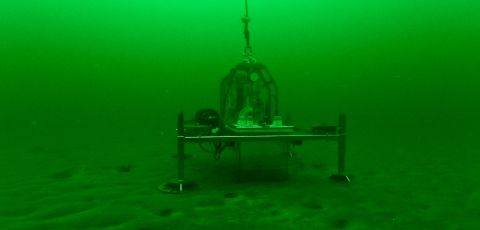
Workpackage 3 - Benthic-pelagic coupling
The dynamic energy in shallow waters has been described above and the pronounced role for biogeochemical processes as well as sediment water coupling. The structure of the seabed is as important for biogeochemical processes as is the type of sediments. Sediments are a diverse habitat in their own right, strongly determined by their meio- and macrofauna colonization. Furthermore, they are sites of intense degradation and other microbial processes interacting with physical and sedimentological processes. When bedforms with sediment ripples exist, the water flow above the sediments creates pressure gradients that entrain nutrients and organic matter, supporting microbial processes in the porewaters (Figure). However, as soon as the bedform ripples start migrating the porewater flows may be reversed and oxygen penetration is even reduced. Nutrient cycling in cohesive vs sandy sediments revealed a high and not yet understood complexity in the many variables impacting the diversity of fauna.
WP3 addresses the following hypotheses.
- The type of sediments (grain size, organic matter content, permeability) and their flushing characteristics determine fluxes of biogeochemical constituents that vary on spatial and time scales requiring novel high-frequency data acquisition.
- Physical forcing attributed to climate change (heat waves, storm events, upwelling of anoxic waters, etc.) leads to both local and long-term changes in sediment-water fluxes and sediment functions.
- Resuspension-induced transports of nutrients from the shallow regions into the deep layers (not affected by waves) matter.
- The variability of subsurface heterogeneity and seafloor microtopography has a significant impact on coastal filter functionsand thus for the overall offshore transport of nutrients and organic matter.
- The carbon/nitrogen flux and turnover in the coastal zone is essential to close the carbon/nitrogen budgets in the Baltic Sea.
- Deposition and erosion processes, seasonal OM availability and diurnal light availability all contribute to the variability of benthic carbon dioxide and methane fluxes. Accounting for the CH4 and CO2 fluxes from the coastal zone is a prerequisite for an assessment of the net GHG balance of the Baltic Sea and its sub-basins.
- The specific natural organic matter composition at different coastal sites impacts the removal of relevant organic trace substances. Polyphenols, acting as photosensitizers or quenchers play a major role. Both OM quality and organic pollutant concentrations change over the seasonal cycle, resulting in different associations over time.
- Climate change will affect terrigenous runoff and autochthonous production and, thus, OM and nutrient composition that will in turn impact the DOM pollutant associations.
